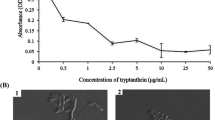Abstract
Susceptibility of Bacillus thuringiensis spores and toxins to the UV-B range (280–330 nm) of the solar spectrum reaching Earth's surface may be responsible for its inactivation and low persistence in nature. Spores of the mosquito larvicidal B. thuringiensis subsp. israelensis were significantly more resistant to UV-B than spores of the lepidopteran-active subsp. kurstaki. Spores of subsp. israelensis were as resistant to UV-B as spores of B. subtilis and more resistant than spores of the closely related B. cereus and another mosquito larvicidal species B. sphaericus. Sensitivity of B. thuringiensis subsp. israelensis spores to UV-B radiation depended upon their culture age; 24-h cultures, approaching maximal larvicidal activity, were still sensitive. Maximal resistance to UV-B was achieved only at 48 h.
Similar content being viewed by others
Author information
Authors and Affiliations
Additional information
Received: 13 December 2000/Accepted: 19 January 2001
Rights and permissions
About this article
Cite this article
Myasnik, M., Manasherob, R., Ben-Dov, E. et al. Comparative Sensitivity to UV-B Radiation of Two Bacillus thuringiensis Subspecies and Other Bacillus sp.. Curr Microbiol 43, 140–143 (2001). https://doi.org/10.1007/s002840010276
Issue Date:
DOI: https://doi.org/10.1007/s002840010276




